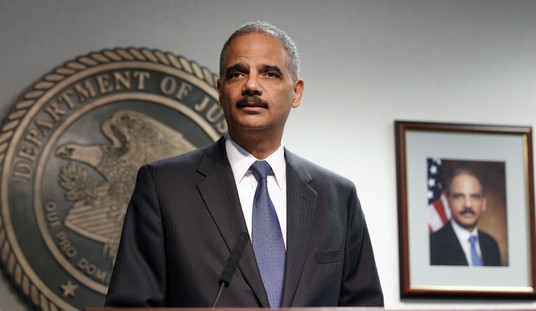And that is largely Barack Obama’s own fault. Two years ago, on another of his short-lived pivots to the economy and jobs, Obama held up Motor City as an example of the comeback of the American economy after three-plus years of his policies, especially his stimulus programs and the bailout of GM and Chrysler. National Journal’s Major Garrett points out the similarities between Obama’s PR campaign in 2011 and now, with Detroit’s collapse as the backdrop:
But Obama’s 2011 speech described a Detroit that can only be described as a myth wrapped in a wish inside a dream.
“This is a city that’s been to heck and back,” Obama said. “And while there are still a lot of challenges here, I see a city that’s coming back.”
Obama referenced “tough choices” made to bail out GM and Fiat-Chrysler and also hailed the birth of a new wave of high-tech employment. “We said American workers could manufacture the best products in the world. So we invested in high-tech manufacturing and we invested in clean energy,” he said. “And right now, there’s an advanced-battery industry taking root here in Michigan that barely existed before.”
The biggest factory in this supposed new trend, Massachusetts-based A123 Systems, had plans to employ 5,900 workers nationwide to build lithium-ion batteries. In Detroit, A123 Systems never employed more than 1,000. The Energy Department awarded A123 Systems a $249 million grant to boost production. It filed forbankruptcy in 2012 and was still receiving DOE largesse. A judge approved the bankruptcy in 2013.
In other words, the Detroit-area advanced-battery industry Obama said “barely existed before” his 2011 speech now … barely exists.
Obama also saluted the White House decision to make Detroit one of its six pilot cities in the “Strong Cities, Strong Communities” program.
“We’re teaming up with everybody—mayors, local officials, you name it—boosting economic development, rebuilding your communities the best way,” Obama said. “This is a city where the great American industry has come back to life and the industries of tomorrow are taking root.”
The biggest accomplishment of this program in Detroit is the demolition of a public housing project. There are also hopes, diminished by the bankruptcy proceedings, of building a $100 million light-rail line. Other “accomplishments” include a “text my bus” system “to provide more reliable information on transportation schedules”—this in a city that has lost half its bus service since 2005 and where budget cuts have eliminated overnight service. The “Strong Cities, Strong Communities” program also envisions the possible development of a regional transportation authority for Detroit.
With public housing being demolished, a text system for late or nonexistent bus service, and a federally funded lithium-ion battery factory that never met its hyped employment plans and then fell into bankruptcy, does any of this sound like, as Obama said, the foundations of a “city where people, brave and bold, courageous and clever, are dreaming up ways to prove the skeptics wrong and write the next proud chapter in our history”?
Not hardly. Obama’s last public-relations campaign on the economy didn’t result in any sweeping change of direction on the policies that produced A123 and Solyndra while doing nothing to slow down Detroit’s collapse. Chris Cillizza and Sean Sullivan at the Washington Post warn readers not to expect anything to change this time around in a political context, either:
“Vision.” “Plan.” “Changing the nature of the conversation.” Obama was laying down a marker; this was going to be a b-i-g speech. Mark it on your calendars.
And yet, during that same OFA fundraiser, Obama acknowledged that no matter how lofty his goals or his rhetoric, the fundamental realities of the politics of the economy were almost certain to remain unchanged. ”I’m excited about the speech, not because I think the speech is going to change any minds,” he said.
Truer words were never spoken.
In the latest Washington Post-ABC News poll, 45 percent of Americans approved of how Obama is handling economic issues while 49 percent disapproved. A year ago, 44 percent approved of Obama’s economic approach — a number statistically unchanged despite the fact that the president swept to a second term thanks, at least in part, to making the 2012 election a referendum on his economic priorities.
A look even further back suggest a remarkable stability in Obama’s numbers on the economy. In October 2010, just before Republicans won 63 House seats to reclaim the majority, 44 percent of Americans approved of Obama’s approach to the economy in Post-ABC polling. Go back a year before that — December 2009 — and Obama’s economic approval is 46 percent.
It won’t change minds because we’ve been doing the same thing for more than four years on economic policy. Obamanomics is nothing but short-term attempts to inject stimulus while ignoring the fundamentals of economic growth — lowering hiring costs, reducing regulation, encouraging capital investments by increasing potential rewards and minimizing risks. We’re doing the opposite across the board, in large part due to ObamaCare, Dodd-Frank, and higher tax bites on capital gains. Short-term stimulus didn’t work with Cash for Clunkers, it didn’t work in Detroit, and it’s not working anywhere else except in Washington DC.
Michael Ramirez summed it up nicely earlier this week at Investors Business Daily:
Also, be sure to check out Ramirez’ terrific collection of his works: Everyone Has the Right to My Opinion, which covers the entire breadth of Ramirez’ career, and it gives fascinating look at political history. Read my review here, and watch my interviews with Ramirez here and here. And don’t forget to check out the entire Investors.com site, which has now incorporated all of the former IBD Editorials, while individual investors still exist.









Join the conversation as a VIP Member